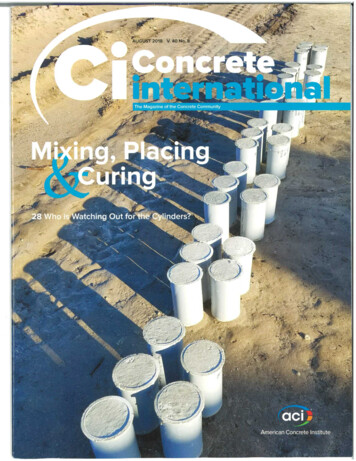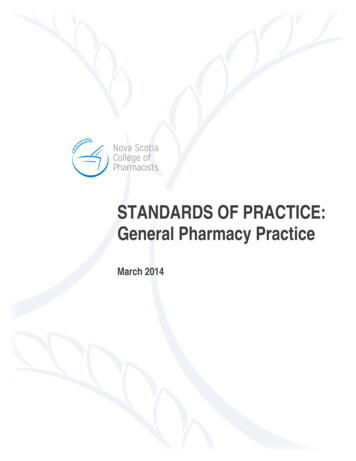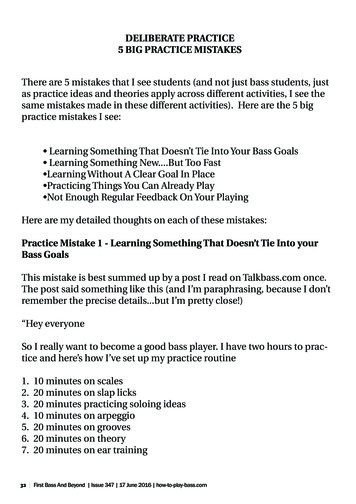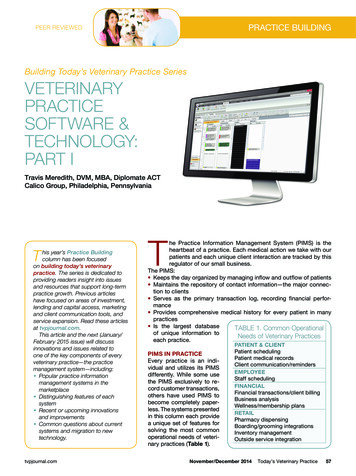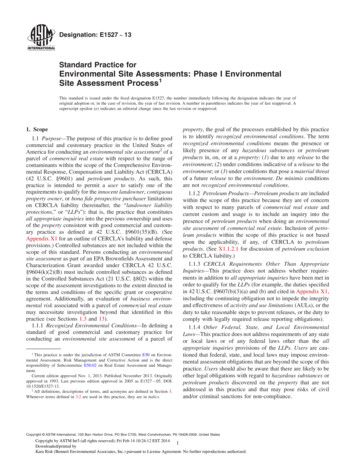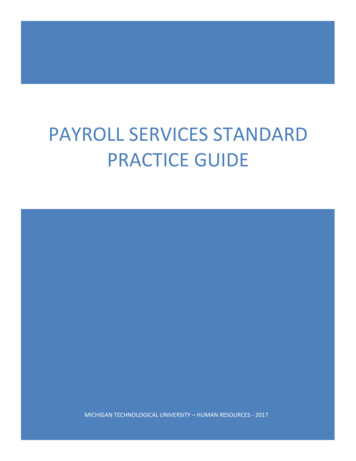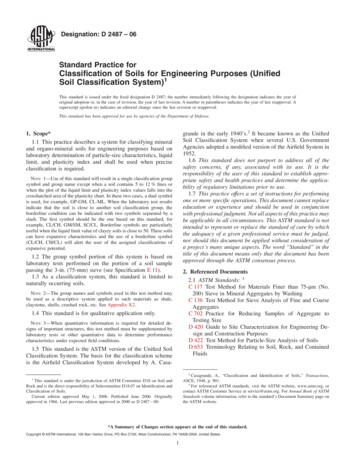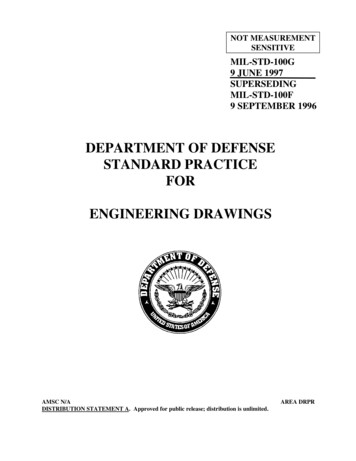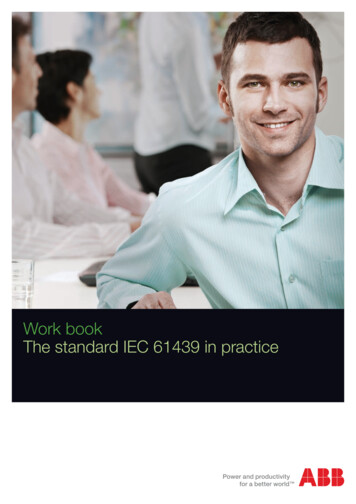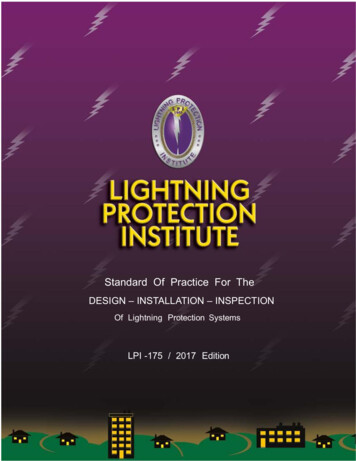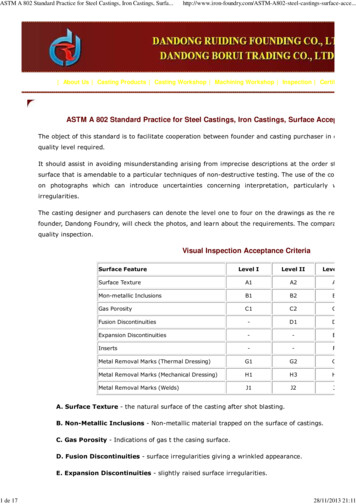
Transcription
This international standard was developed in accordance with internationally recognized principles on standardization established in the Decision on Principles for theDevelopment of International Standards, Guides and Recommendations issued by the World Trade Organization Technical Barriers to Trade (TBT) Committee.Designation: C31/C31M 19Standard Practice forMaking and Curing Concrete Test Specimens in the Field1This standard is issued under the fixed designation C31/C31M; the number immediately following the designation indicates the year oforiginal adoption or, in the case of revision, the year of last revision. A number in parentheses indicates the year of last reapproval. Asuperscript epsilon ( ) indicates an editorial change since the last revision or reapproval.1. Scope*2. Referenced Documents1.1 This practice covers procedures for making and curingcylinder and beam specimens from representative samples offresh concrete for a construction project.1.2 The concrete used to make the molded specimens shallbe sampled after all on-site adjustments have been made to themixture proportions, including the addition of mix water andadmixtures. This practice is not satisfactory for making specimens from concrete not having measurable slump or requiringother sizes or shapes of specimens.1.3 The values stated in either SI units or inch-pound unitsare to be regarded separately as standard. The values stated ineach system may not be exact equivalents; therefore, eachsystem shall be used independently of the other. Combiningvalues from the two systems may result in non-conformancewith the standard.1.4 This standard does not purport to address all of thesafety concerns, if any, associated with its use. It is theresponsibility of the user of this standard to establish appropriate safety, health, and environmental practices and determine the applicability of regulatory limitations prior to use.(Warning—Fresh hydraulic cementitious mixtures are causticand may cause chemical burns to exposed skin and tissue uponprolonged exposure.2)1.5 The text of this standard references notes which provideexplanatory material. These notes shall not be considered asrequirements of the standard.1.6 This international standard was developed in accordance with internationally recognized principles on standardization established in the Decision on Principles for theDevelopment of International Standards, Guides and Recommendations issued by the World Trade Organization TechnicalBarriers to Trade (TBT) Committee.1This practice is under the jurisdiction of ASTM Committee C09 on Concreteand Concrete Aggregates and is the direct responsibility of Subcommittee C09.61on Testing for Strength.Current edition approved Jan. 1, 2019. Published January 2019. Originallyapproved in 1920. Last previous edition approved in 2018 as C31/C31M–18b. DOI:10.1520/C0031 C0031M-19.2See Section on Safety Precautions, Manual of Aggregate and Concrete Testing,Annual Book of ASTM Standards, Vol. 04.02.2.1 ASTM Standards:3C125 Terminology Relating to Concrete and Concrete AggregatesC138/C138M Test Method for Density (Unit Weight), Yield,and Air Content (Gravimetric) of ConcreteC143/C143M Test Method for Slump of Hydraulic-CementConcreteC172/C172M Practice for Sampling Freshly Mixed ConcreteC173/C173M Test Method for Air Content of Freshly MixedConcrete by the Volumetric MethodC231/C231M Test Method for Air Content of Freshly MixedConcrete by the Pressure MethodC330/C330M Specification for Lightweight Aggregates forStructural ConcreteC403/C403M Test Method for Time of Setting of ConcreteMixtures by Penetration ResistanceC470/C470M Specification for Molds for Forming ConcreteTest Cylinders VerticallyC511 Specification for Mixing Rooms, Moist Cabinets,Moist Rooms, and Water Storage Tanks Used in theTesting of Hydraulic Cements and ConcretesC617/C617M Practice for Capping Cylindrical ConcreteSpecimensC1064/C1064M Test Method for Temperature of FreshlyMixed Hydraulic-Cement ConcreteC1077 Practice for Agencies Testing Concrete and ConcreteAggregates for Use in Construction and Criteria forTesting Agency EvaluationC1611/C1611M Test Method for Slump Flow of SelfConsolidating ConcreteC1758/C1758M Practice for Fabricating Test Specimenswith Self-Consolidating Concrete2.2 American Concrete Institute Publication:4309R Guide for Consolidation of Concrete3For referenced ASTM standards, visit the ASTM website, www.astm.org, orcontact ASTM Customer Service at service@astm.org. For Annual Book of ASTMStandards volume information, refer to the standard’s Document Summary page onthe ASTM website.4Available from American Concrete Institute (ACI), P.O. Box 9094, FarmingtonHills, MI 48333-9094, http://www.aci-int.org.*A Summary of Changes section appears at the end of this standardCopyright ASTM International, 100 Barr Harbor Drive, PO Box C700, West Conshohocken, PA 19428-2959. United StatesCopyright ASTM InternationalProvided by IHS Markit under license with ASTMNo reproduction or networking permitted without license from IHS-- ,, ,, , , , , , ,- - ,, ,, , ,, ---This standard has been approved for use by agencies of the U.S. Department of Defense.1Licensee Dept of Transportation/5950087001, User Ead, SamirNot for Resale, 10/23/2019 08:05:16 MDT
C31/C31M 193. TerminologyThe inside surfaces of the molds shall be smooth. The sides,bottom, and ends shall be at right angles to each other and shallbe straight and true and free of warpage. Maximum variationfrom the nominal cross section shall not exceed 3 mm [ 1 8 in.]for molds with depth or breadth of 150 mm [6 in.] or more.Molds shall produce specimens at least as long but not morethan 2 mm [1 16 in.] shorter than the required length in 6.2.3.1 For definitions of terms used in this practice, refer toTerminology C125.3.2 Definitions of Terms Specific to This Standard:3.2.1 initial curing temperature, n—temperature of the environment surrounding the specimen during initial curing.3.2.1.1 Discussion—The environment surrounding the testspecimens may be air, water, or sand. The temperature of theenvironment surrounding the test specimen might not be thesame as the concrete temperature.5.4 Tamping Rod—A round, smooth, straight, steel rod witha diameter conforming to the requirements in Table 1. Thelength of the tamping rod shall be at least 100 mm [4 in.]greater than the depth of the mold in which rodding is beingperformed, but not greater than 600 mm [24 in.] in overalllength (see Note 1). The rod shall have the tamping end or bothends rounded to a hemispherical tip of the same diameter as therod.4. Significance and Use4.1 This practice provides standardized requirements formaking, curing, protecting, and transporting concrete testspecimens under field conditions.NOTE 1—A rod length of 400 mm [16 in.] to 600 mm [24 in.] meets therequirements of the following: Practice C31/C31M, Test Method C138/C138M, Test Method C143/C143M, Test Method C173/C173M, and TestMethod C231/C231M.4.2 If the specimens are made and standard cured, asstipulated herein, the resulting strength test data when thespecimens are tested are able to be used for the followingpurposes:4.2.1 Acceptance testing for specified strength,4.2.2 Checking adequacy of mixture proportions forstrength, and4.2.3 Quality control.5.5 Vibrators—Internal vibrators shall be used. The vibratorfrequency shall be at least 150 Hz [9000 vibrations per minute]while the vibrator is operating in the concrete. The diameter ofa round vibrator shall be no more than one-fourth the diameterof the cylinder mold or one-fourth the width of the beam mold.Other shaped vibrators shall have a perimeter equivalent to thecircumference of an appropriate round vibrator. The combinedlength of the vibrator shaft and vibrating element shall exceedthe depth of the section being vibrated by at least 75 mm [3in.]. The vibrator frequency shall be checked periodically witha vibrating-reed tachometer or other suitable device.4.3 If the specimens are made and field cured, as stipulatedherein, the resulting strength test data when the specimens aretested are able to be used for the following purposes:4.3.1 Determination of whether a structure is capable ofbeing put in service,4.3.2 Comparison with test results of standard cured specimens or with test results from various in-place test methods,4.3.3 Adequacy of curing and protection of concrete in thestructure, or4.3.4 Form or shoring removal time requirements.NOTE 2—For information on size and frequency of various vibratorsand a method to periodically check vibrator frequency see ACI 309R.5.6 Mallet—A mallet with a rubber or rawhide head weighing 0.6 6 0.2 kg [1.25 6 0.50 lb] shall be used.5.7 Placement Tools—of a size large enough so each amountof concrete obtained from the sampling receptacle is representative and small enough so concrete is not spilled duringplacement in the mold. For placing concrete in a cylinder mold,the acceptable tool is a scoop. For placing concrete in a beammold, either a shovel or scoop is permitted.5. Apparatus5.1 Molds, General—Molds for specimens or fasteningsthereto in contact with the concrete shall be made of steel, castiron, or other nonabsorbent material, nonreactive with concretecontaining portland or other hydraulic cements. Molds shallhold their dimensions and shape under all conditions of use.Molds shall be watertight during use as judged by their abilityto hold water poured into them. Provisions for tests of waterleakage are given in the Test Methods for Elongation,Absorption, and Water Leakage section of Specification C470/C470M. A suitable sealant, such as heavy grease, modelingclay, or microcrystalline wax shall be used where necessary toprevent leakage through the joints. Positive means shall beprovided to hold base plates firmly to the molds. Reusablemolds shall be lightly coated with mineral oil or a suitablenonreactive form release material before use.5.8 Finishing Tools—a handheld float or a trowel.5.9 Slump Apparatus—The apparatus for measurement ofslump shall conform to the requirements of Test MethodC143/C143M.5.10 Sampling Receptacle—The receptacle shall be a suitable heavy gauge metal pan, wheelbarrow, or flat, cleannonabsorbent board of sufficient capacity to allow easy remixing of the entire sample with a shovel or trowel.5.2 Cylinder Molds—Molds for casting concrete test specimens shall conform to the requirements of SpecificationC470/C470M. Cardboard cylinder molds shall not be used forstandard-cured specimens.TABLE 1 Tamping Rod Diameter RequirementsDiameter of Cylinderor Width of Beammm [in.] 150 [6] 150 [6]-- ,, ,, , , , , , ,-5.3 Beam Molds—Beam molds shall be of the shape anddimensions required to produce the specimens stipulated in 6.2.Copyright ASTM InternationalProvided by IHS Markit under license with ASTMNo reproduction or networking permitted without license from IHS2Licensee Dept of Transportation/5950087001, User Ead, SamirNot for Resale, 10/23/2019 08:05:16 MDTDiameter or Rodmm [in.]10 2 [3 8 1 16 ]16 2 [5 8 1 16 ]
C31/C31M 195.11 Air Content Apparatus—The apparatus for measuringair content shall conform to the requirements of Test MethodsC173/C173M or C231/C231M.maximum aggregate size between 19.0 and 25.0 mm [ 3 4 and 1 in.], theratio between the modulus of rupture determined with a 150 by 150 mm[6 by 6 in.] and a 100 by 100 mm [4 by 4 in.] may vary from 0.90 to 1.075and for maximum aggregate size between 9.5 and 37.5 mm [ 3 8 and 11 2in.], the ratio between the modulus of rupture determined with a 150 by150 mm [6 by 6 in.] and a 115 by 115 mm [4.5 by 4.5 in.] may vary from0.86 to 1.00.65.12 Temperature Measuring Devices—The temperaturemeasuring devices shall conform to the applicable requirements of Test Method C1064/C1064M.6.3 Field Technicians—The field technicians making andcuring specimens for acceptance testing shall meet the personnel qualification requirements of Practice C1077.6. Testing Requirements6.1 Cylindrical Specimens—Compressive or splitting tensilestrength specimens shall be cylinders cast and allowed to set inan upright position. The number and size of cylinders cast shallbe as directed by the specifier of the tests. In addition, thelength shall be twice the diameter and the cylinder diametershall be at least 3 times the nominal maximum size of thecoarse aggregate. When the nominal maximum size of thecoarse aggregate exceeds 50 mm [2 in.], the concrete sampleshall be treated by wet sieving through a 50-mm [2-in.] sieveas described in Practice C172/C172M. For acceptance testingfor specified compressive strength, cylinders shall be 150 by300 mm [6 by 12 in.] or 100 by 200 mm [4 by 8 in.] (Note 3).7. Sampling Concrete7.1 The samples used to fabricate test specimens under thisstandard shall be obtained in accordance with Practice C172/C172M unless an alternative procedure has been approved.7.2 Record the identification of the sample with respect tothe location of the concrete represented and the time of casting.8. Slump, Slump Flow, Air Content, and Temperature8.1 Slump or Slump Flow—After remixing the sample in thereceptacle, measure and record the slump or slump flow inaccordance with Test Method C143/C143M or Test MethodC1611/C1611M, respectively, for each sample of concretefrom which specimens are made.NOTE 3—When molds in SI units are required and not available,equivalent inch-pound unit size mold should be permitted.6.2 Beam Specimens—Flexural strength specimens shall bebeams of concrete cast and hardened in the horizontal position.The length shall be at least 50 mm [2 in.] greater than threetimes the depth as tested. The ratio of width to depth as moldedshall not exceed 1.5.6.2.1 The minimum cross-sectional dimension of the beamshall be as stated in Table 2. Unless otherwise specified by thespecifier of tests, the standard beam shall be 150 by 150 mm [6by 6 in.] in cross section.6.2.2 When the nominal maximum size of the coarseaggregate exceeds 50 mm [2 in.], the concre
Designation: C31/C31M . 2.1 ASTM --Standards:3 C125 Terminology Relating to Concrete and Concrete Ag- ates - ,, ,, , ,, greg- C138/C138M Test Method for Density (Unit Weight), Yield, and Air Content (Gravimetric) of Concrete C143/C143M Test Method for Slump of Hydraulic-Cement Concrete C172/C172M Practice for Sampling Freshly Mixed Con- ,, ,, , , , , , ,--crete C173/C173M Test .File Size: 399KBPage Count: 6Explore furtherASTM C31 - Making and Curing Concrete Test Specimens in .owlcation.comASTM C31.pdf Concrete Building Engineeringwww.scribd.comASTM C31 - ACI Making and Curing Concrete Test . - SI Certswww.sicerts.comASTM C31 / C31M - 21a Standard Practice for Making and .www.astm.orgACI C172-04 Sampling Freshly Mixed Concrete Sampling .www.scribd.comRecommended to you based on what's popular Feedback
